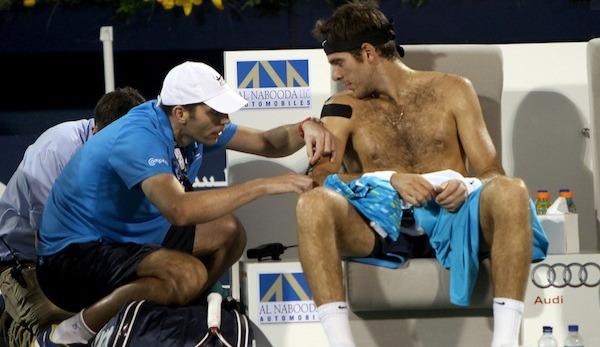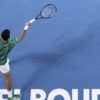The shoulder joint is particularly hard working in tennis and is therefore particularly susceptible to injury. Amateurs as well as professionals have to fight here again and again with problems. Reason enough for us, in cooperation with the Department of Sports Orthopaedics and Arthroscopic Surgery of the Tabea Hospital, to take a detailed look at the causes, treatment options and prevention of shoulder injuries.
Massages, bittersalt baths, ginger, gentle stretching exercises – there are many home remedies and tips to help with light shoulder complaints. But if the pain is severe or even chronic, going to the doctor is unavoidable. The methods of treatment vary depending on the type of injury.
The first step is always a detailed and exact anamnesis: When the complaints occur, how long have the problems already existed, there were injuries in advance. The next step is a sports medical examination with examination of the mobility as well as special muscle and function tests. On this basis, the physician usually already has an idea of the diagnosis, the confirmation of which is confirmed using equipment such as ultrasound, X-rays or MRI/CT. Once the diagnosis is made, the treatment follows.
The most common type of injury in the shoulder is that of the rotator cuff. How this can happen, we have already explained to you in the last part of our series. Especially Tommy Haas not only suffered from such an injury once in the course of his career and ultimately also had to undergo surgery. Dr. Mathias Himmelspach: “If the rotator cuff is torn, surgery is usually recommended for active athletes. Here the tendon is reattached to the bone using a keyhole technique (arthroscopy).”
In such a case, a rehabilitation period of at least six months must be expected, and it often takes a year for the shoulder to be able to resume full physical activity. Dr. Himmelspach continues: “In my opinion, there is no quick recovery within a few weeks or even days in the shoulder area. The joint is too complexly muscular, and the subtle interplay of the various muscles for the extreme movements must first be restored.”
Chronic overuse damage is more common in the shoulder area. For example, the recurring extreme movements of the impact arm during impact lead to one-sided adjustment processes of the joint capsule. If these are not detected and treated at an early stage, the rotator cuff may be damaged.
Maria Sharapova also had problems with the rotator cuff during her career. But that wasn’t the only shoulder injury the Russian suffered. In 2013 she had to cancel her participation in the US Open due to bursitis – another common shoulder problem. If such bursitis has been diagnosed, it is particularly important to protect the affected shoulder. Until the pain subsides, a training break should be observed, otherwise there is the danger that the bursitis will persist in the long term.
However, there is no need to do without physical exercise completely. As soon as an improvement occurs, one can start again with an easy training. Usually it takes a few days until the first symptoms and pain subside, explains Dr. Himmelspach.
As a result of a fall, further acute problems can occur, which must absolutely be in the hands of a specialist. These include, for example, an injury to the acromioclavicular joint (AC joint) or a shoulder luxation (dislocation).
In acromioclavicular disruption, the form of therapy depends on the degree of instability. Slight injuries of the acromioclavicular joint (ACG) are usually treated conservatively. The shoulder is immobilized for a few days with a Gilchrist bandage, followed by physiotherapy. Downtimes of approx. 4-6 weeks have to be expected here.
On the other hand, high-grade ACG instabilities, especially in overhead athletes, as is the case in tennis, should be treated surgically. In most cases, this is done with minimally invasive or arthroscopic support, whereby full, unrestricted resilience is usually only restored after four months.
In 95% of cases of shoulder luxation, the head of the humerus slips forward and downward out of the socket due to a fall on the arm that is spread backwards and rotates outwards. Ligaments tear at the shoulder and the joint capsule is overstretched. In the conservative treatment, first the shoulder is reset and then fixed with a bandage for a few days. However, young athletes under 30 years of age have a high risk of up to 80% of shoulder dislocation without surgery.
However, such a therapy decision also depends on the respective situation of the athlete. Of course, a tennis player can be treated conservatively in principle, otherwise – e.g. due to an operation – it should mean the end of the current season for him. Although it may return to the site after a few weeks, it is also at high risk of dislocation of the shoulder joint (recidivluxation).
In individual cases, the attending physician will always discuss the options and risks and thus also the necessity of a stabilizing operation in detail with the athlete, assessing all factors. If the decision for the stabilizing operation is made, this means a loss of at least four to nine months for the athlete, depending on the surgical technique.
However, the healing process is usually not yet complete with the treatment. There is still a lot to consider in retrospect when you resume your training. Dr. Himmelspach recommends: “In many cases it is very helpful to specifically train the so-called balancing muscles and to improve posture including the mobility of the shoulder”.
Of course, it is best not to suffer a shoulder injury in the first place. In the next part of our series we will explain how you can take precautions here. So: continue reading and don’t miss our follow-up articles!














You must be logged in to post a comment Login